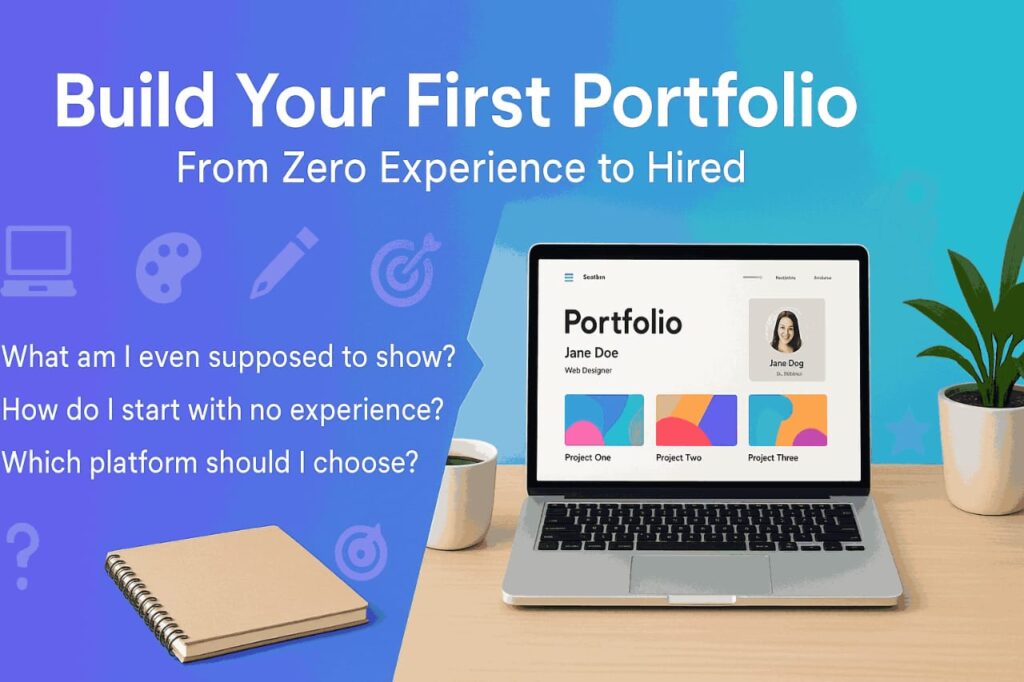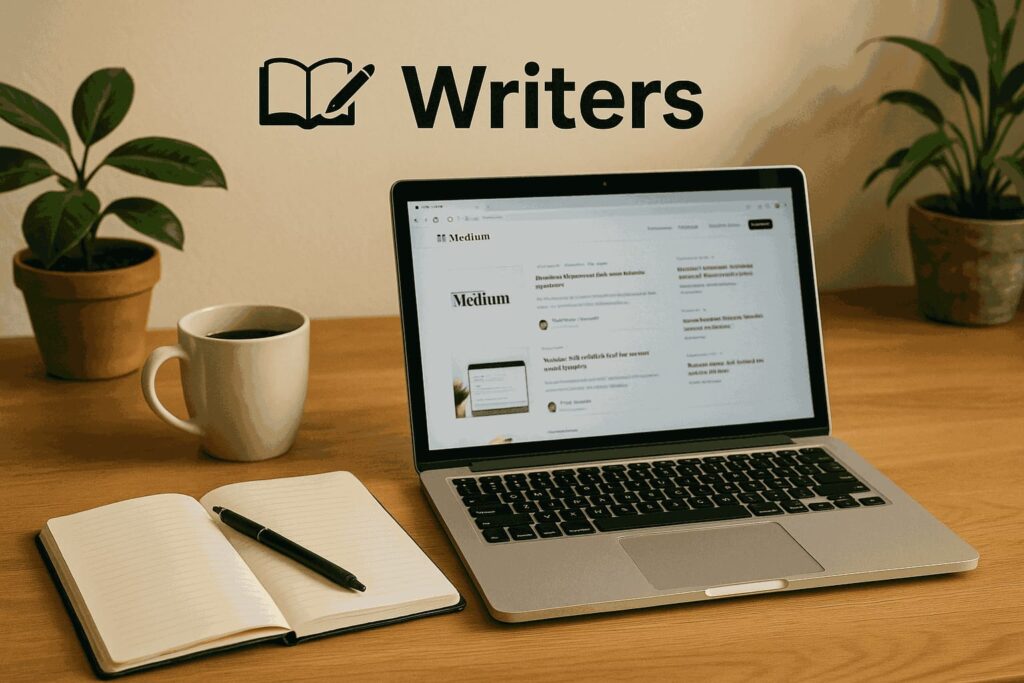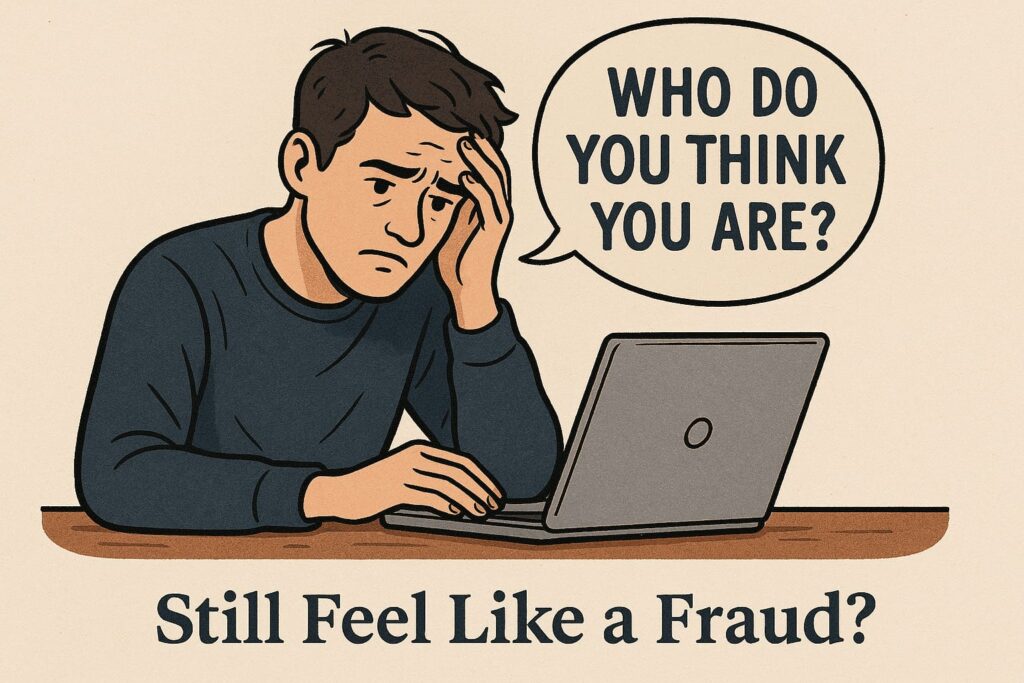
Let me be real with you for a second: building a portfolio when you literally have no experience feels awkward. Like, “What am I even supposed to show?”
I’ve been there. Most of us have. And if you’re in your 20s or early 30s, especially trying to stand out in the U.S. job or freelance market, you need to get this right.
So let’s break it down, human to human.
🧱 But I Don’t Have Anything to Show
Okay. Breathe.
Here’s the thing: a portfolio isn’t just about work you were paid to do. It’s about showing what you can do.
Let me tell you a quick story:
When I started as a freelance writer, I had zero clients. Nada. But you know what I did? I wrote three sample blog posts, just the kind I wanted to get hired for. Posted them on Medium. Sent those links to potential clients.
Landed my first gig within two weeks.
Whether you’re a:
- 💻 Developer: Build a small app or clone something cool (Spotify, a weather app, or whatever).
- 🖌️ Designer: Redesign a popular app for fun, or mock up branding for a fictional brand.
- ✍️ Writer: Write 2–3 killer sample blog posts, copy, emails, or whatever fits your niche.
👉 Tip: Label these as “personal projects” or “passion work” and be upfront. No one’s judging.
🛠️ “What Should I Include in My Portfolio?”
Keep it clean, focused, and real. Here’s the basic starter pack:
- A short, personality-filled About Me (Not boring, please. Talk like you.)
- 2–5 sample projects (Fake, real, or collaborative doesn’t matter)
- A clear list of skills/tools you use
- Contact info (or a call to action like “Hire me,” “Let’s chat,” etc.)
Optional but cool:
- Testimonials (ask friends, classmates, or past collaborators)
- Resume (PDF link or embedded, your call)
🌐 Best Portfolio Sites (Without Going Broke or Losing Your Mind)

Look, I’ll be honest: you don’t need to spend $300 on some premium template when you haven’t even uploaded your first project yet. Just pick something that feels right and lets you show your stuff.
That’s literally all it needs to do.
Here’s what I’ve either used or seen people absolutely kill it with:
📝 Writers
- Medium Super easy to start with. If you want to blog and not mess with design, this works.
- Journo Portfolio Clean, simple, and does the job. Honestly? The free version is enough when you’re starting.
- Notion Kinda nerdy, kinda aesthetic. Great if you like organising things and keeping it minimal.
👨💻 Developers
- GitHub Pages is free. Dev-friendly. If you’re even a little bit comfortable with code, this one’s a no-brainer.
- Netlify + your own code— This is what I did for a while. Total control, but yeah, a bit more work.
- Notion or Framer These are great if you want it to look good without writing 500 lines of CSS.
🎨 Designers
- Behance Pretty much standard. Clients actually browse it.
- Dribbble I know it’s a little saturated now, but still great for visibility.
- Adobe Portfolio If you already pay for Creative Cloud, this is kind of a hidden gem. It looks pro.
Here’s the thing most people don’t realize: your platform doesn’t matter nearly as much as your content.
Seriously. Just pick one. Put your work on it. Done is better than perfect, especially in the beginning.
😬 Still Feel Like a Fraud?

Yeah… been there. Still go there sometimes.
Let’s be real; everyone feels like a total fraud at some point. Even the folks with years of experience and shiny titles. Imposter syndrome doesn’t care how many projects you’ve done.
You know that little voice in your head that goes,
“Who do you think you are?”
“What if they find out you’re not actually that good?”
Yeah, that guy? He’s loud. But you don’t have to believe him.
Here’s what I’ve learned (the hard way): confidence isn’t about feeling ready; it’s about showing up anyway.
Clients and employers? They don’t need you to be perfect.
They just want to know:
- Can you do the thing?
- Will you show up?
- Are you easy to work with?
If your portfolio says
“Here’s what I do. I care about it. And I’m not here to waste your time.”
Boom, you’re already ahead of 90% of people who are too scared to even try.
Also, and I can’t stress this enough, if you don’t show up online, you kind of don’t exist.
Especially in today’s remote, digital-first work culture.
📸 My First Portfolio? A Total Mess (But It Worked)
I’ll be honest, the first time I published my portfolio, I felt so fake. 😅
I had, like… three half-finished projects, a headshot I took with my phone propped on a stack of books 📸, and a bio I rewrote 12 times because I couldn’t stop cringing at my own words.
But you know what? Someone still reached out.
It wasn’t perfect, not even close. But I showed up. And that made all the difference. ✨
You don’t need to be famous.
You just need to be findable.
👀 Quick Real Talk: What Not to Do
Okay, rapid-fire style. No fluff. Just stuff I wish someone told me earlier. 👇
⚖️ Quick Snapshot: Don’t vs Do
| ❌ Don’t | ✅ Do This Instead |
|---|---|
| Copy someone’s layout or vibe | Ship it now, tweak it later |
| Write like a corporate resume | Talk like a normal human being would |
| Obsess over fonts, colors, perfection | Use your real voice even if it’s a little awkward. 😅 |
| Wait till you have “enough” experience | Start with whatever you’ve got |
| Sound formal and robotic | Obsess over fonts, colours, and perfection |
Real talk: People don’t want “perfect.” They want real.
If your personality shows through your portfolio, you’re already doing better than 90% of folks who are stuck overthinking. 🧠✨
Bonus Tip:
Tweak your copy like you’re texting a friend who’s hiring you.
Not writing to impress your school principal 😎
✨ Final Thoughts (And a Little Pep Talk)

Looking to build a portfolio when you have zero experience? It’s not about pretending to be something you’re not.
It’s about showing the world:
“Hey, I may be new, but I’m ready.”
- You don’t need a fancy degree.
- You don’t need a big-name client.
- You don’t even need to have it all figured out.
You just need something that says:
“This is who I am. This is what I love doing. Want to work together?”
So don’t wait. Seriously.
Write that sample piece. 🎯
Design that fake landing page. 🎨
Rebuild your favorite app just for the heck of it.
Offer to redo your cousin’s bakery website if you have to. 🍩
Just… start. Messy, small, imperfect, whatever.
Momentum over perfection. Every time.
And hey, when you finally launch your portfolio (even if it’s one page and barely finished),
Send me the link.
I mean it. I’d love to see what you made. 🖤
📌 TL;DR In Case You’re Skimming (I See You 👀)
- No experience? Cool. Make sample stuff.
- Use free tools to get online fast.
- Pick platforms based on what you do (writing ≠ coding ≠ design).
- Keep it simple. Keep it honest. Keep it you.
- Don’t overthink. Just start.
If you’ve read this far, you’re already ahead of most people who say they’ll start “someday.”
So go ahead. Make something today.
Hit publish. Be proud of it.
The rest? You’ll figure it out as you go. 🚀
📎 A Quick Real-World Win (Mini Case Study)
How Maya Got Her First Client With a Free Notion Page”
Maya was a recent bootcamp grad with zero clients and a serious case of imposter syndrome.
She threw together a portfolio in Notion nothing fancy, just:
- A clean About section
- 2 personal projects
- One blog post on her learning process
She posted it on LinkedIn with the caption:
Still learning, still building. Here’s what I’ve done so far.”
And boom, within a week, she got a message from a startup founder looking for help on a part-time project.
No resume. No interview. Just her work, out in the world. 🌍
🛠️ Helpful (and Free) Tools You Can Use Today
| Purpose | Tool |
|---|---|
| Portfolio inspiration | Bestfolios |
| Free images | Unsplash |
| Project idea prompts | Buildspace or Copy.ai |
| Landing page builder | Framer or Carrd |
| Easy site builder | Notion + Super |
💬 Bookmark this section. Steal ideas. Remix what works for you.
Because getting something live is way more important than making it “perfect.”
If you want to get more information like this, then click here
Q: If I don’t have any client work, is making a portfolio pointless?
Not at all.
Honestly, when I was starting out, I had zero client projects.
Just three personal ones: a blog post, a fake redesign, and a free collaboration with a friend.
And guess what? Those were enough to land me work. People aren’t always looking for paid experience; they want proof that you can do the work. That’s it.
Q: What’s the very first step when making a portfolio?
Start simple.
Think about who you’re trying to impress. Are you applying for jobs? Looking for freelance gigs? Building credibility?
When I built my first one, I knew I wanted freelance content clients. So I crafted my portfolio for them with a clean layout, relevant samples, and a clear contact button. Once you know your audience, everything else becomes easier.
Q: How many projects should I include?
Honestly? Quality over quantity.
2 or 3 solid, thoughtful projects are better than 5 half-done ones.
Even just one strong project, explained with good context and visuals, can work wonders.
I landed my first paid writing gig with just one article. But it was well-written, well-structured, and showed how I think.
Q: Can I use LinkedIn as my portfolio?
Kind of, but not completely.
LinkedIn is great for networking and building a presence, but it’s not a focused portfolio.
That said, I do get leads from LinkedIn, but I always include a separate portfolio link so people can dive deeper into my work.
Q: Is it okay to build my portfolio on Notion? Does it look professional?
Absolutely if done well.
Notion is clean, easy to update, and surprisingly professional when structured properly.
I’ve seen a Notion portfolio from a writer that was so simple but felt super polished because their content was strong and the layout was intentional.
So yes, Notion is totally valid. Especially for writers, devs, and minimalist designers.
Q: Should I buy my own domain name?
Eventually, yes.
You don’t need it on day one, but as soon as you’re serious about your work grab a yourname.com domain.
When I bought mine, one of the first things a client said was:
“I loved that you had a real domain. It made you look legit.”
It’s a small investment ($10–15/year) that can seriously boost your credibility.
Q: Should all portfolios follow the same structure?
Nope.
Different professions need different portfolio flows:
Writers: easy-to-read text, links to articles
Designers: visual-heavy, clear layout
Developers: demos, GitHub, code snippets
I once wrote a post for designers, and it was clear visuals are everything to them. But devs? They care more about how clean your code is and what it does.
So tailor it. One-size-fits-all doesn’t really work here.
Q: Are testimonials important? What if I don’t have any?
Not critical, but definitely helpful.
When I was starting, I had no real clients but I did a small free project for a friend and asked them for a one-line testimonial.
That little quote made my site feel more human and trustworthy.
So yeah, if you’ve helped anyone even informally just ask for a quick sentence of feedback. You’ll be surprised how much it helps.
Q: What should I do after building my portfolio?
Promote the heck out of it.
When I publish a new portfolio or update it, I don’t just let it sit there. I post about it on LinkedIn, tweet it, and DM it to people I want to work with.
Having a portfolio is great but showing it to the world is where the magic happens.
My first big lead came just because I shared my site in a casual “Hey, just launched my portfolio” post. People clicked. Someone hired me. Simple as that.
Pingback: The Stock Market Guide for Beginners (2025)
Pingback: Top 8 Exchange Rate Truths (Tipo de Cambio) Every Traveler & Freelancer Should Know